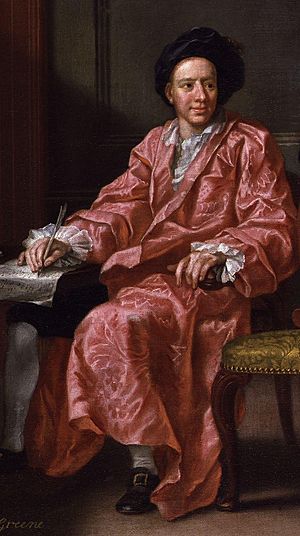Maurice Greene (composer) facts for kids
Maurice Greene (born August 12, 1696 – died December 1, 1755) was a famous English composer and organist. He lived during a time when music was changing, and he helped shape the sound of English music.
Life of Maurice Greene
Maurice Greene was born in London. His father was a clergyman, which is a religious leader. When he was young, Maurice became a choirboy at St Paul's Cathedral. This meant he sang in the church choir. His teachers there were Jeremiah Clarke and Charles King.
Maurice also learned to play the organ from Richard Brind. After Brind passed away, Maurice took over his job as the organist at St Paul's Cathedral.
In 1727, another famous musician named William Croft died. Maurice Greene then became the organist at the Chapel Royal. This was a very important musical role for the King. In 1730, he became a Professor of Music at Cambridge University. Then, in 1735, he was given the special title of Master of the King's Musick. This meant he was the King's main musician.
Maurice Greene was working on a big collection of church music called Cathedral Music. Sadly, he died before he could finish it. His student, William Boyce, who also became Master of the King's Musick, completed the work. Many songs from this collection are still used in Anglican church services today.
His Music Style
Maurice Greene wrote music that was popular in England during his time. He was especially known for his longer church songs called Verse Anthems. His most famous piece is Lord, let me know mine end. This song uses a sad text and features many different musical parts playing together. It also has a beautiful section for two high voices.
His organ music, which was published after he died, is also very special. It's more thoughtful and complex than some other organ music from that period.
Maurice Greene passed away in 1755 when he was 59 years old. He was first buried in a church called St Olave Old Jewry. Later, when that church was taken down in 1887, his remains were moved to St Paul's Cathedral.
Main Works
Greene wrote many different kinds of music, both for church and for other performances.
- The anthem Hearken Unto Me, Ye Holy Children (1728)
- The oratorio The Song of Deborah and Barak (1732)
- The oratorio Jephtha (1737)
- The opera Florimel (1734)
- Musical settings for sonnets from Edmund Spenser's Amoretti (1739)
- A collection of anthems (1743), including his famous Lord, let me know mine end
- The opera Phoebe (finished in 1747)
He also published music for keyboard instruments like the harpsichord or spinet:
- Choice Lessons (London, 1733)
- 6 Overtures … in Seven Parts (London, 1745)
- A Collection of Lessons (London, 1750)
- Twelve Voluntarys, for organ or harpsichord (published after his death in 1779)
Free scores
- Free scores by Maurice Greene in the Choral Public Domain Library (ChoralWiki)
- Maurice Greene: Free scores at the International Music Score Library Project
| Court offices | ||
|---|---|---|
| Preceded by John Eccles |
Master of the King's Music 1735–1755 |
Succeeded by William Boyce |
| Cultural offices | ||
| Preceded by William Croft |
First Organist of the Chapel Royal 1727–1755 |
Succeeded by James Nares |
| Preceded by Richard Brind |
Organist and Master of the Choristers of St Paul's Cathedral 1718–1755 |
Succeeded by John Jones |
| Preceded by Thomas Tudway |
Professor of Music, Cambridge University 1730–1755 |
Succeeded by John Randall |
See also
 In Spanish: Maurice Greene (compositor) para niños
In Spanish: Maurice Greene (compositor) para niños


